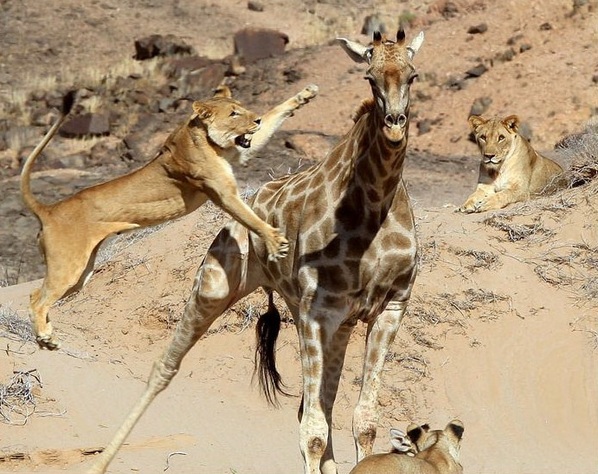
ff Our study sites experience large seasonal variation in interaction oen ft discussed in natural communities (Holt, 1977 Holt ungulate density and biomass as migratory herds of thousands of wilde- & Lawton, 1994 Paine, 1966). Shared predation in two or more prey species is an indirect species, giraes. ing levels of lion density and primary prey density, providing an op- Indirect interactions arise when the eect ff of one species on another portunity to examine how variation in predator and migratory primary is mediated by the action of a third species (Abrams, 1987 Wooon, tt prey densities aect ff ed neonatal and calf survival in a secondary prey 1994). The role of indirect trophic interactions in the ecology and evolu- Our TE study area encompassed five distinct but connected sites tion of organisms is a long- standing topic among ecologists (Estes, surveyed in three seasons each year yielding spatiotemporally contrast- Brashares, & Power, 2013 Schmitz, Hambäck, & Beckerman, 2000). LL Let l 8403 INTR ODUCTION predators of giraes, ff and may be the primary cause of death for girae ff calves (Dagg, 2014 Dagg & Foster, 1976 Strauss & Packer, 2013). Ecology and Evolution Ecology and Evolution 2016 6: 8402–8411 published by John Wiley & Sons Ltd. KEYWORDS asynchronous reproduction, juvenile survival, life history, mammal, match–mismatch, natural enemy, population dynamics, predator–prey ratio, prey switching This is an open access article under the terms of the Creative Commons Attribution License, which permits use, distribution and reproduction in any medium, provided the original work is properly cited. Our results suggest that the widespread popula- tion declines observed in many migratory systems are likely to trigger demographic impacts in other species due to indirect effects like those shown here. If wildebeest and zebra popu- lations in this ecosystem continue to decline as a result of increasingly disrupted mi- grations and poaching, then giraffe calves will face increased predation pressure as the predator–prey ratio increases. Natural predation had a significant effect on giraffe calf and neonate survival, and could significantly affect giraffe population dynamics. This supports the apparent mutualism hypothesis that the pres- ence of migratory ungulates reduces lion predation on giraffe calve s. We found that local lion predation pressure (lion density divided by primary prey density) was significantly negatively correlated with giraffe neonatal and calf sur - vival probabilities. We examined neonatal survival via apparent reproduction of 860 adult fe- males, and calf survival of 449 giraffe calves, during three precipitation seasons over 3 years, seeking evidence of some effect on neonate and calf survival as a consequence of the movements of large herds of migratory ungulates. We used demographic data from five subpopulations of giraffes in the Tarangire Ecosystem of Tanzania, East Africa, to test hypotheses relating to direct predation and indirect effects of large migratory herds on calf survival of a resident megaher- bivore. (Equus quagga), while lion predation on secondary prey such as giraffes (Giraffa camelo- pardalis) may change according to the relative abundance of the primary prey species.


African lions (Panthera leo) are generalist predators Zoo Tulsa Zoo Dartmouth College Cramer whose primary, preferred prey are wildebeests (Connochaetes taurinus) and zebras Fund the Explorer’s Club. Scholar Program Sacramento Zoo Safari West Columbus Zoo Cincinnati mediated by their shared predator.

We utilized a large- mammal predator–prey savanna food web to evaluate support for Funding information hypotheses relating to the indirect effects of “apparent competition” and “apparent mu- Dartmouth College Graduate Studies tualism” from migratory ungulate herds on survival of resident megaherbivore calves, Fulbright U.S. taking advantage of the large seasonal shifts in migratory prey b iomass. Lee, Wild Nature Institute, Hanover, NH, USA. Such systems offer an opportunity to empirically in- Correspondence vestigate cyclic population density effects on short- term food web interactions by Derek E. In long- distance migratory systems, local fluctuations in the predator–prey ratio Studies, Karatu, Tanzania can exhibit extreme variability within a single year depending upon the seasonal Tanzania National Parks, Arusha, Tanzania location of migratory species. Tarangire Lion Project, School for Field 1. Migratory herds of wildebeests and zebras indirectly affect calf survival of giraffes Migratory herds of wildebeests and zebras indirectly affect calf survival of giraffes


 0 kommentar(er)
0 kommentar(er)
